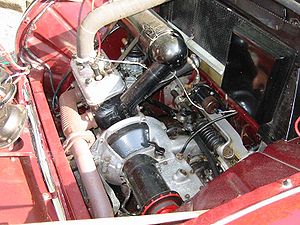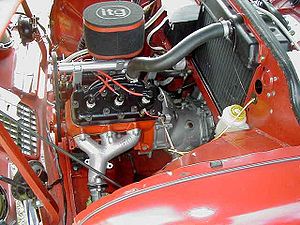
Saab two-stroke
Encyclopedia


Saab Automobile
Saab Automobile AB, better known as Saab , is a Swedish car manufacturer owned by Dutch automobile manufacturer Swedish Automobile NV, formerly Spyker Cars NV. It is the exclusive automobile Royal Warrant holder as appointed by the King of Sweden...
two-stroke
Two-stroke cycle
A two-stroke engine is an internal combustion engine that completes the process cycle in one revolution of the crankshaft...
engine was based on a DKW
DKW
DKW is a historic German car and motorcycle marque. The name derives from Dampf-Kraft-Wagen .In 1916, the Danish engineer Jørgen Skafte Rasmussen founded a factory in Zschopau, Saxony, Germany, to produce steam fittings. In the same year, he attempted to produce a steam-driven car, called the DKW...
design. The SAAB engine, a two-cylinder
Cylinder (engine)
A cylinder is the central working part of a reciprocating engine or pump, the space in which a piston travels. Multiple cylinders are commonly arranged side by side in a bank, or engine block, which is typically cast from aluminum or cast iron before receiving precision machine work...
with 764 cc engine displacement
Engine displacement
Engine displacement is the volume swept by all the pistons inside the cylinders of an internal combustion engine in a single movement from top dead centre to bottom dead centre . It is commonly specified in cubic centimeters , litres , or cubic inches...
and 25 hp
Horsepower
Horsepower is the name of several units of measurement of power. The most common definitions equal between 735.5 and 750 watts.Horsepower was originally defined to compare the output of steam engines with the power of draft horses in continuous operation. The unit was widely adopted to measure the...
was transversally placed in the 1950 - 1956 Saab 92
Saab 92
Saab 92 is an automobile from Saab. The design was very aerodynamic for its time, and the cW value was 0.30 . The entire body was stamped out of one piece of sheet metal and then cut to accommodate doors and windows. Full-scale production started December 12, 1949, based on the prototype Saab 92001...
, giving it a top speed of 100 kilometre per hour. With the 1954 model engine output was raised to 28 hp. It had some features only found in modern cars such as one ignition coil per cylinder.
The second type of SAAB two stroke engine was a longitudinally placed 3 cylinder of 748 cc and initially 33 hp. This engine was used in the Saabs 93
Saab 93
The Saab 93, pronounced ninety-three, is an automobile manufactured by Saab. It was announced on August 18, 1955, and was first presented on December 1, 1955. It was styled by Sixten Sason and had a longitudinally-mounted three-cylinder 748 cc Saab two-stroke engine giving 33 hp . The...
, 94 (Sonett I, with an engine tuned
Engine tuning
Engine tuning is the adjustment, modification or design of internal combustion engines to yield optimal performance, to increase an engine's power output, economy, or durability....
to 57,5 hp), Saab Sonett
Saab Sonett
The Saab Sonett is an automobile manufactured between 1955 and 1957 and again between 1966 and 1974 by Saab Automobile AB of Sweden. Sonetts shared engines and other components with Saab 96s and 95s of the same era....
II, 95
Saab 95
The Saab 95 was a 7-seater, 2-door station wagon made by Saab. Initially it was based on the Saab 93 sedan version, but the model's development throughout the years followed closely that of the 96 since the 93 was put off the market in 1960...
, 96
Saab 96
For the modern car, see Saab 9-6The Saab 96 is an automobile made by Saab. It was introduced in 1960 and was produced until January 1980, a run of 20 years. Like the 93 it replaced, the 96 was a development from the old Saab 92 chassis and, on account of its improvements and modernisation, it...
, Saab GT750
Saab GT750
Saab GT750 is an automobile from Saab produced between 1958 and 1960. It was introduced at the New York International Auto Show in 1958, and was fitted with safety belts as standard - soon afterward the practice became commonplace on most cars.The GT750 was a sporty version of the Saab 93, mainly...
, the Saab Formula Junior
Saab Formula Junior
right|thumb|300px|Saab Formula Juniorthumb|300px|Saab Formula JuniorThe Saab Formula Junior was a 1960 car by the Swedish car maker Saab.In 1960 the Saab 93f was being replaced by the Saab 96 and a new 841 cc engine was developed...
and the Saab Quantum
Saab Quantum
SAAB Quantum was a series of 5 SAAB cars built in the USA. The earliest cars used Saab 93 two-stroke engines, transmissions and suspension. The later cars used Saab 96 drivetrains and suspension parts....
. The engine is fitted with a belt driven DC dynamo
Dynamo
- Engineering :* Dynamo, a magnetic device originally used as an electric generator* Dynamo theory, a theory relating to magnetic fields of celestial bodies* Solar dynamo, the physical process that generates the Sun's magnetic field- Software :...
combined with a coolant water pump
Centrifugal pump
A centrifugal pump is a rotodynamic pump that uses a rotating impeller to create flow by the addition of energy to a fluid. Centrifugal pumps are commonly used to move liquids through piping...
.
The 1958-59 Sports
Saab Sport
Saab Sport is an automobile from Saab, launched in 1962 as a replacement for the Saab GT750. It used the same body shell as the Saab 96, with slight modifications and with a different interior configuration and equipment...
version of the 93B had 48-50 hp in base version and 57 hp in super version. This model had triple carburetor
Carburetor
A carburetor , carburettor, or carburetter is a device that blends air and fuel for an internal combustion engine. It is sometimes shortened to carb in North America and the United Kingdom....
s and a motor oil
Motor oil
Motor oil or engine oil is an oil used for lubrication of various internal combustion engines. The main function is to lubricate moving parts; it also cleans, inhibits corrosion, improves sealing, and cools the engine by carrying heat away from moving parts.Motor oils are derived from...
injection system, rather than oil pre-mixed with the petrol.
From 1959 displacement was raised to 841 cc with 38 hp. For model year 1966, the 'standard' 3-cylinder two-stroke engine was fitted with triple carburetors. From model year 1967 it was replaced with the Ford Taunus V4 engine
Ford Taunus V4 engine
The Taunus V4 was a V4 piston engine with one balance shaft, introduced by Ford Motor Company in Germany in 1962. The German V4 was built in the Cologne plant and powered the Ford Taunus and German versions of the Granada, Capri and Transit...
.
SAAB also made some experimental V6 engine
V6 engine
A V6 engine is a V engine with six cylinders mounted on the crankcase in two banks of three cylinders, usually set at either a right angle or an acute angle to each other, with all six pistons driving a common crankshaft...
s, by mounting two three cylinder two-stroke engines together, at an angle. One had carburetors on the outside, while another was more conventional, with a carburetor in between the two blocks.
See also
- Saab MonsterSaab Monsterthumb|250px|Saab 'Monster'The Saab Monster was an experimental car made by Saab in 1959. This project was part of Saab's work in motorsport and the need to derive more power from their two-stroke powerplant. It consisted of a 'Toreador Red' Saab 93 with all excess weight removed, including the...

